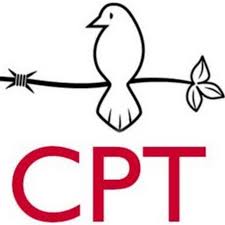The Price of Empire
Despite the heavy heat outside, the basement was cool, almost damp, with the smell of old crumbling concrete and years of dust storms. It was dark but a light glowed, soaking everything in a sinister red film, showing the way through, showing their faces, twisted with fear, and pain, and loss.
Pictures hung on the walls, one per wall. Large, almost life sized images of fallen bodies, decaying children, bloated cows. I stood in silence. I know the history, the decades of brutality, of ethnic cleansing, the systematic murder of Kurdish men, women and children in the 1980s; Saddams al’Anfal campaign.
I had even seen those pictures before. But this was different; the horror was close and chilling. I left the basement, up the stairs, leaving the exhibition of the Halabja victims behind me. Stepping into the sunlight, a soft rain was falling. Mohammed, our friend, was waiting, cigarette in mouth, chatting with the guide.
A desk within one of Amna Suraka's interrogation rooms.
Amna Suraka, the “Red Security” prison stands in the middle of Sulaimani, a monument to the Anfal campaign and the abusive control of the Kurdish people during the years of Saddam Hussein. Amna Suraka still stands as a statement of Kurdish defiance. Never again will they be treated like animals, abused, beaten, raped, tortured, dehumanized simply for being Kurdish. In the ‘80s Amna Suraka was the hub of Saddam’s control in the city. The barracks, the administration offices, the prison, the interrogation rooms, the solitary confinement cells, all necessary structures in keeping people under control. Mohammed remembers those days; he was a teenager then. He was silent as he sat on the steps, but he remembered, I could see it in his face, the pain of memories, family and friends lost, maybe to this prison.
For Mohammed’s pain, my home is partly to blame. For the 182,000 Anfal victims, my country is partly to blame. The UK sold Saddam some of the arms's that he used against Iran and also sold arms to Iran to use against Saddam too. We also sold Saddam chemicals that he used to make his chemical weapons. Weapons he used against Iran and the Iraqi Kurds.
The main administration building.
The British continued to supply Saddam all the way through the Anfal. The chance that none of these arm's and chemicals were used against the Kurds is pretty small. And we knew exactly what Saddam was doing, yet we kept supplying. We have excuses of course; the ‘80s were a time of recession, and we needed the money and Saddam like other ”unsavory” characters was willing to pay. We accepted in the name of British interests. My interests.
I watched Mohammed, sitting on the steps of one of Amna Suraka’s buildings; smoking silently. I had to ask myself what had I gained at the cost of his people. My education, my “free” healthcare partly paid for by the deaths of so many Kurds. It is not enough to say that Kurdish blood is on our collective hands. We are up to our necks in it, and in the blood of countless other peoples from all over the world, the remnants of our Empire.
By Pat Thompson

